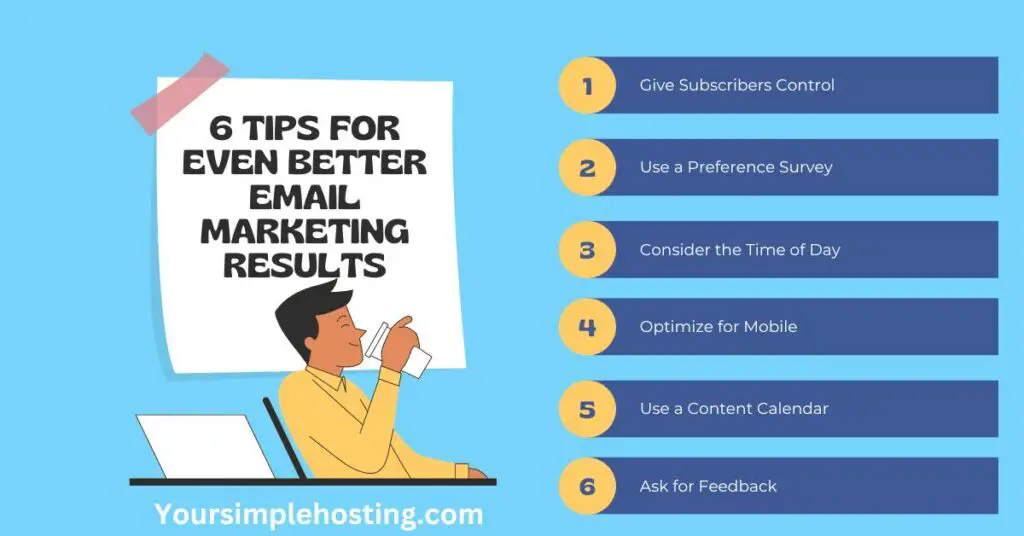Email marketing has been one of the most effective tools for businesses to engage with customers and promote their products or services. However, deciding how often to send emails can be tricky.
Too many emails can overwhelm your subscribers and result in unsubscribing, whereas fewer emails can result in missed opportunities to connect with your audience. Aim for between 2 – 3 emails a week.
In this article, I’ll list the best practices for how often to send email marketing campaigns so that you can achieve maximum engagement and ROI.

Table of Contents
10 Best Practices on How Often to Send Marketing Emails
1. Segment Your Email List
Email specific groups based on their interests, behaviors, and preferences. This can help you personalize the content and frequency of your emails to match their needs and preferences.
2. Consistency is Key
Be consistent in sending emails. Your subscribers should know when to expect emails from you, whether weekly, biweekly, or monthly. This helps to build trust with your audience.
3. Test and Analyze
Test different sending frequencies to determine what works best for your audience. Analyze your open, click-through, and unsubscribe rates to determine which frequency yields the best results.
4. Avoid Sending Too Frequently
Over-sending can lead to fatigue and disengagement from your subscribers. Sending too many emails can lead to a higher unsubscribe rate and lower engagement.
5. Personalize Your Email Content
Personalize the content of your emails based on the subscriber’s behavior, preferences, and interests. This can lead to higher engagement rates and better ROI.
6. Consider the Time of Day and Day of the Week
Send emails at times when your subscribers will likely engage with your content. This may vary depending on your industry, audience demographics, and location.
7. Use Triggered Emails
They’re automatically sent based on the subscriber’s actions or behaviors. This can include welcome emails, abandoned cart emails, and post-purchase follow-ups.
8. Use a Concise Call-to-Action
Your emails should have a short and concise call-to-action (CTA) that motivates subscribers to take action. This can include clicking a link, purchasing, or filling out a form.
9. Monitor Your Email Frequency
Keep track of your email frequency and adjust as needed. If you notice a drop in engagement or a boost in unsubscribe rates, it may be time to change your sending frequency.
10. Quality Over Quantity
Ultimately, the quality of your emails is more important than the quantity. Therefore, send only relevant, engaging, and valuable emails.

6 Tips for Even Better Email Marketing Results
The following tips can step up your email marketing:
Give Subscribers Control
Give subscribers the ability to choose the frequency of emails they receive. This can be done by including a preference center where they can adjust the frequency of emails they receive.
Use a Preference Survey
Send a survey to your subscribers about their preferred email frequency. This can give you valuable insights into their preferences and help you tailor your email frequency accordingly.
Consider the Time of Day
Consider the time of day when sending emails, which can affect open rates. Test different sending times to see what works best for your audience.
Optimize for Mobile
Ensure your emails are optimized for mobile devices, as more people read emails on their smartphones. This can help improve open rates and engagement.
Use a Content Calendar
Plan your email content using a content calendar. This can help you space out your emails and avoid sending too many at once.
Ask for Feedback
Ask for feedback from subscribers on your email frequency and content. This can help you better understand their needs and preferences and adjust your email marketing accordingly.
Frequently Asked Questions (FAQs)
How Important is Timing in Email Marketing?
Timing is crucial in email marketing. Sending emails at the right time can increase open and click-through rates.
So, consider the time of day, day of the week, and time zone of your subscribers when determining the best time to send your emails.
The industry, audience demographics, and location can also affect the ideal timing of your emails. Testing different sending times can help you determine the optimal email timing.
How Often Should You Send Emails for Email Marketing?
A typical frequency is sending emails weekly. However, email marketing frequency should be determined based on the campaign’s goals and the subscribers’ preferences.
Find the sweet spot–send enough emails to keep your subscribers engaged, but don’t send too many. Otherwise, you might see a drop in your subscriptions.
Maintaining email consistency also matters so subscribers know when to expect your emails. For example, you can determine the optimal sending frequency for your audience by testing different frequencies and analyzing engagement rates.
How Many Emails Per Day Is Too Much for Marketing?
As mentioned, sending too many emails can negatively affect your business, as most people don’t enjoy receiving many emails daily.
It’s generally recommended to send no more than 1-2 emails daily, depending on your goals and subscribers’ preferences. However, the ideal frequency can vary depending on the industry, audience demographics, and location.
Why Should a Company Avoid Sending the Same Emails to Every Single One of Their Subscribers?
Sending the same email to every subscriber can lead to a lack of personalization and relevance, resulting in lower engagement rates and higher unsubscribe rates.
Companies should segment their email list based on subscriber behavior, interests, and preferences to personalize their emails and accomplish higher engagement rates, better ROI, and more loyal customers.
What is the Ideal Weekly Email Frequency for Marketing?
The ideal weekly email frequency for marketing can vary depending on the campaign’s goals, the subscribers’ preferences, and the industry.
Experts recommend sending at least one email per week to maintain engagement, but the ideal frequency can vary, depending on the audience. Sending 2 – 3 emails weekly seems to be the sweet spot for engagement.
Testing different frequencies and analyzing engagement rates can help determine your audience’s ideal weekly email frequency.
Conclusion
Finding the right balance between too many and insufficient emails is trial and error.
Still, following the best practices above, you can optimize your email marketing strategy for maximum engagement and conversion rates.
Remember, your email subscribers aren’t robots. They’re real people, so consider their preferences and needs when deciding how often to send emails.

Leave a Reply